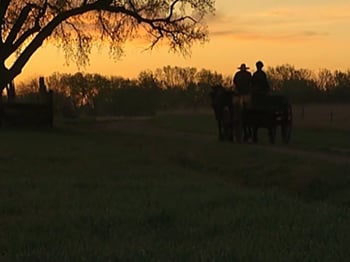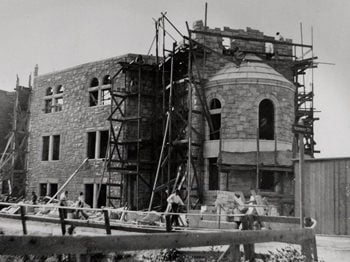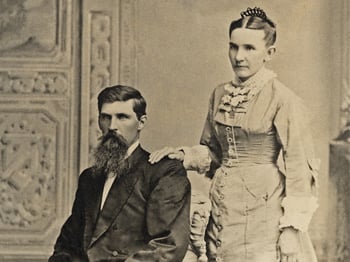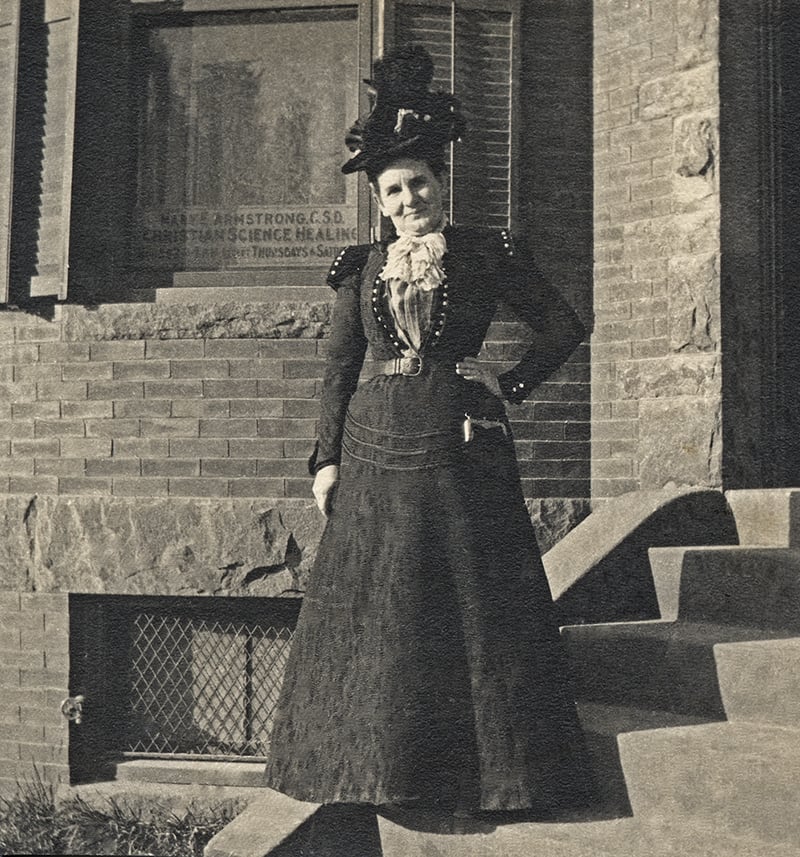
When Mary Armstrong came into the ranks of Christian Scientists, she came wholeheartedly and humbly. The wife of a successful businessman and banker in Irving, Kansas, she had a comfortable life financially, but chronic illness and a prognosis by physicians that she would never recover had left her hopeless regarding her health. Her introduction to Christian Science — being healed by it — brought a fresh outlook and a commitment by this young mother not only to help others, but to serve in whatever way she could the Discoverer, Founder, and Leader of Christian Science, Mary Baker Eddy.
Husband Joseph Armstrong embraced Christian Science immediately upon seeing its healing effect on his young wife. That healing took place in 1886, when Mary was 27 years old. That same year saw the couple taking class instruction in Christian Science from Janet Colman, a student of Mrs. Eddy.
The following year, in November 1887, they had the privilege of meeting Mrs. Eddy, and taking her Primary Class in Christian Science at the Massachusetts Metaphysical College in Boston. Like others at this early point in the history of the Christian Science movement, they found their lives redirected by this experience.
It had not been easy for the Armstrongs to leave on their trip to Boston. They were the parents of two young boys, ages three and seven. Upon hearing of their plans to go, little three-year-old George became determined to go with them, was insistent that Mrs. Eddy wanted him there, and that he was going! Putting George to bed that night was no simple task — he declared he would not go to sleep, but would go to Boston. They eventually were able to leave on a late train without the boy, and shared this story with Mrs. Eddy when they met her. She laughed and said to them, “He has a determined nature that should be cultivated.”1
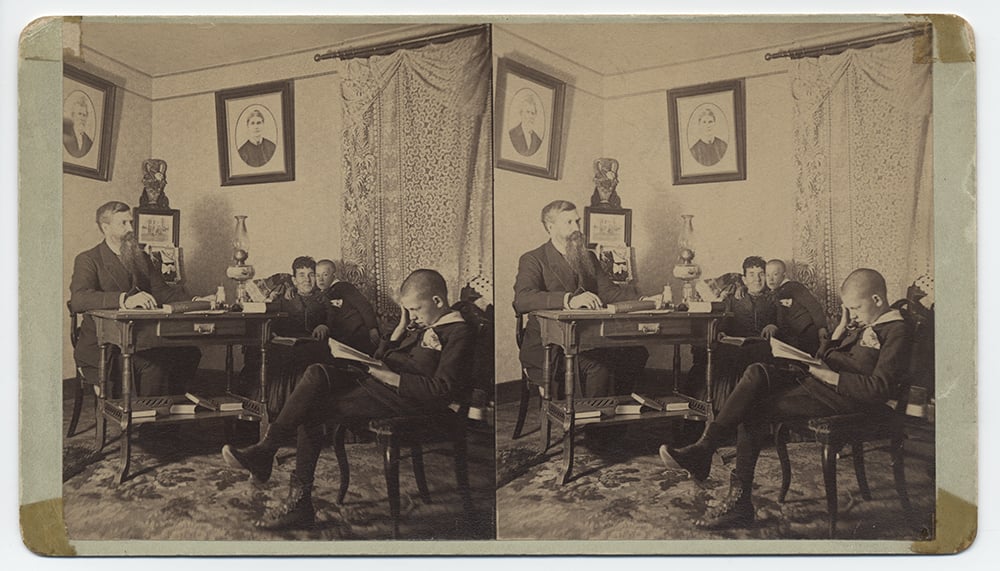
Mrs. Eddy asked why they had not brought the children, to which they replied they didn’t think children were allowed in class. To their surprise she said they were! A year and a half later, when the couple came to Boston in May 1889 to take the Normal course at the College, the Armstrong children did come. Mrs. Eddy taught only the first session of the course that May, but as she did, younger son George sat most of the time right on the platform with her!
Ready and willing to serve, soon after that class Mary and Joseph Armstrong gave their entire time to the Cause of Christian Science. They had been listed in The Christian Science Journal as public practitioners of Christian Science since 1888, and they pioneered the healing work both in Kansas and Ohio. When Joseph was called to Boston at Mrs. Eddy’s request in 1892 to serve as publisher of the Journal and Manager of the Christian Science Publishing Society, Mary moved her practice to Boston.
It is interesting to note that while Joseph may be the more recognized of the pair because of his prominent roles in the early movement, Mary made her own important contributions. In addition to her many years of consecrated healing work, Mary was ever ready to assist Mrs. Eddy and her household in practical ways.
In a reminiscence in the Longyear Museum collection, Mrs. Armstrong recalls that during the summer of 1898 she was paid a visit by Laura Sargent, a member of the household at Pleasant View. Mrs. Eddy was in urgent need of temporary domestic help. Even though Mary was preparing to move her family to a new residence in Boston, and even though she had maids of her own and hadn’t done her own housework for years, her immediate response was “I will go stay with Mrs. Eddy until she can get help.”2 Kindly, Mrs. Sargent, Janet Colman, and Mary’s two maids took care of the packing and move to the new home.
Mary served at Pleasant View as cook — spending many hours in the kitchen in the heat of summer — which was a challenge for her. She later wrote “I found all kinds of arguments of error to hinder me from staying with Mrs. Eddy. I was tried on all sides to give up and go home.”3 In a letter of support to her, husband Joseph wrote:
“…I see it is error for us to give up for one moment that you are not going to be able to do what ever is necessary.… I will write you a good big letter tomorrow. Hope to get one from you today telling me you are feeling better. Remember I know you are. So goodbye my dear girl.
Your loving Joe”4
She proved to be an excellent and tidy cook — learning to prepare some of Mrs. Eddy’s favorite foods quite successfully — and an alert household member. Mrs. Eddy’s praise, gratitude, friendship, and priceless teachings made the experience one that Mary treasured. After a few weeks, Mrs. Eddy let her return home when she saw that Mary was needed there by her teen-aged boys.
Mary found other ways to be of help from her home base of Boston. She served on a committee that found household workers for Mrs. Eddy. She also shopped for food, clothes, and other household items for Mrs. Eddy. The Longyear Museum collection includes letters sent to her by Mrs. Eddy’s household that give a sense of the special relationship she had with them in this capacity. And living in Boston afforded her close proximity to Quincy Market, where she could purchase high quality fresh foods.
Clara Shannon writes at one time “Thank you much for sending the squab & grapes on Saturday…. I will send a telegram this evening asking you to send another squab tomorrow morning.”5 And on another occasion “Will you please look for some lamb (not mutton) chops that are tender and send about 2 pounds of them tonight or to-morrow morning? … You are not forgotten although you do not hear from me. I always remember with gratitude your help, kindness & love.”6
Letters from Laura Sargent include these comments and requests:
“The fruit, clams and myself arrived in perfect condition…. We had the clams for supper and Mother [Mrs. Eddy] enjoyed them.”7
“We need some sweet fruit for Mother. Will you kindly go down to Isaac Lock’s [Quincy Market] … See if they have any hot house grapes not the imported for they are not sweet. I hope they will have some sweet plums and pears. Just send a few not too many at a time. I should think a doz of plums and ½ doz pears and 1 lb of grapes … Send the bill with the fruit.”8
“Mr. Frye asked me where those gum drops came from that you brought up with the other candy. I told him I did not know but would write to you to bring up some for him the next time you came. He said he like[d] them better than the other candy and it is so very seldom that he ever expresses a wish for any thing I know you will be delighted to get him some. Shall look for you this week some time. With love to you and all the family.”9
Again, in 1906, Mary was asked to serve in Mrs. Eddy’s household, this time for a period of three years. Her children were now grown: the eldest son was married and the younger one was in college. Mary made arrangements for the running of her own home and prepared to go, but at the last minute Mrs. Eddy sent word for Mary not to come at this time — that she was more needed at home — and expressed her appreciation for Mary’s willingness to serve. It is likely Mrs. Eddy had become aware that Joseph Armstrong had been ill, and needed the support of his wife at home.
Some years later Mrs. Armstrong wrote, “Christian Science as she [Mrs. Eddy] taught it to me and the correct understanding I gained of it from her instructions has never been dimmed, rather has it been more illumined as I progress in my riper years and larger lessons. It was my great privilege to be a member of Mrs. Eddy’s household for a time and to serve her in many capacities, to receive her well done for work accomplished, her daily teaching face to face, and her confirmation that I had a correct understanding of Christian Science.”10
Mary Armstrong was an active Christian Science practitioner until her passing in 1937.
